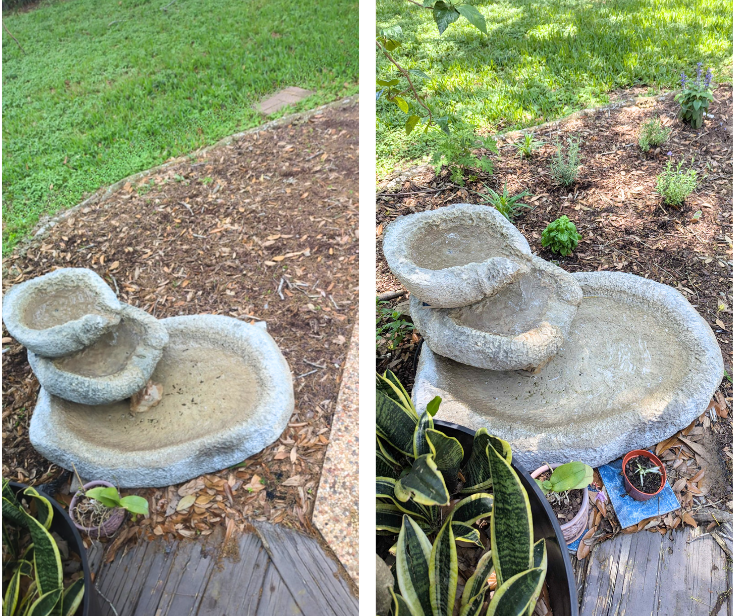As someone who works in digital marketing, I’m always looking at new tools and trends not just through a consumer lens, but through a client-focused one. Since a good portion of my job entails managing digital strategy for clients who depend on organic traffic, I wanted to see for myself what all the buzz (and anxiety) was about.
So when I got access to Google’s new AI Search beta, I didn't just play with the prompts--I put it to work. Specifically, I used it to plan a small garden flower bed that gets dappled western sun in my backyard.
 The experience was surprisingly seamless. I asked questions like “what perennials grow well in southeast Texas” and “the best plants for a backyard that gets a lot of dappled Western sunlight,” and the AI didn’t just give vague answers, it pulled in helpful, region-specific details, from recommended plants to spacing layouts. I appreciated the option to click into source articles, but honestly, I didn’t need to. The summaries were complete and clear on their own. AI Mode offered region-specific answers, pulling from a wide set of data points and delivering them in clear, actionable bullet points. I barely had to leave the summary.
The experience was surprisingly seamless. I asked questions like “what perennials grow well in southeast Texas” and “the best plants for a backyard that gets a lot of dappled Western sunlight,” and the AI didn’t just give vague answers, it pulled in helpful, region-specific details, from recommended plants to spacing layouts. I appreciated the option to click into source articles, but honestly, I didn’t need to. The summaries were complete and clear on their own. AI Mode offered region-specific answers, pulling from a wide set of data points and delivering them in clear, actionable bullet points. I barely had to leave the summary.

And that right there is where this becomes a much bigger conversation.
Helpful? Absolutely. But from a marketing perspective, that's both exciting and a little unsettling.
What Exactly Is Google AI Mode?
According to Google, AI Mode is a next-generation search experience powered by a custom version of Gemini 2.0. It blends the summary-focused style of AI Overviews with the conversational depth of a chatbot. Currently available through Search Labs, early access is being prioritized for Google One AI Premium subscribers.
The big shift? Instead of just serving up links or paraphrasing content, AI Mode synthesizes responses independently, drawing from its broader understanding of web content. It still shows supporting links (if confidence is low), but the core goal is to provide a complete end-to-end answer in a single interaction.

And it’s working. As Ryan Haines from Android Authority described it as “equal parts search engine and chatbot,” and even admitted he “might not search any other way again.”
What This Means for Businesses
AI Mode changes where and how visibility happens. Instead of relying on the traditional funnel of search → click → conversion, your content needs to earn its spot in the answer itself.
This shift invites a new kind of strategy, one focused on visibility without the visit. When done right, your content becomes the source AI Mode leans on, putting your expertise and brand in front of users at the exact moment they need it, even if they don’t click through.
In this environment, your best-performing assets won’t just attract; they’ll inform, build trust, and show up, with or without the traffic report to prove it.
Clickless Search Is Now Real
If users can get full answers without leaving Google, traffic to your site may decrease, even if you’re the original source. This is especially true for how-to content, definitions, and simple product comparisons.
EEAT Isn’t Optional Anymore
Google is prioritizing content with expertise, authority, and trustworthiness. If your site isn’t demonstrating that, through bylines, source credibility, helpful formatting, and internal consistency, you’re less likely to be featured in AI responses.

Your Content Needs to Feed the Model
It’s not just about keywords anymore. It’s about publishing content that gives Google’s model enough structure and context to use. Think formatted headings, in-depth answers, location-specific details, and schema markup.
Brand Awareness Still Lives in AI Summaries
Even if users don’t click, they see your brand when you’re cited or your product is named. In other words, the top of the funnel just moved to a different channel. Your job is to make sure your messaging survives that transition.
The Good News?
AI Mode doesn’t mean the end of SEO. It means the bar has been raised. Businesses that create valuable, well-organized, and genuinely helpful content may gain even more exposure, just in a different format.
From my own test, planning a backyard garden, I appreciated the speed, clarity, and contextual accuracy. I do wish I could’ve uploaded a photo or layout sketch, it would’ve made the responses even more tailored. (Google says multimodal capabilities are on the way, so that feature might not be far off.)
Still, so far, the results speak for themselves.
My Personal Takeaway
From my perspective, AI Search isn't some future threat; it's already reshaping how people find information. Planning my garden with the help of AI Mode showed me just how practical and intuitive it can be. It’s changing the way people search, and by extension, how we market.
It’s easy to view that shift with suspicion (especially if your KPIs rely on traffic). For marketers and clients alike, this is a moment to adapt. AI search provides the chance to double down on what works, creating content that solves real problems, earns real trust, and adapts to new formats as they emerge.
The goal now isn’t just to get clicks, it’s to focus on rich, user-first content, building trust through clarity and expertise. It’s to be useful enough that the AI picks you first and to recognize that, in this new landscape, helping might just be the new ranking.
Want help figuring out how your business can develop this type of content? Let's chat.


